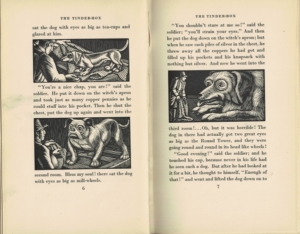
Valediction No.11: First Four
Brian Alderson is saying goodbye to his books as he donates his remarkable collection of children’s books to Seven Stories. Here he bids farewell to a collection of Hans Christian Andersen stories illustrated by Gwen Raverat.
A couple of years ago saw the centenary of the founding of the Society of Wood Engravers and in 2022 Simon Lawrence published a richly annotated and illustrated record of the Society’s first twenty years (1920-1940) in two mighty folio volumes at his Fleece Press. The leading purpose of the Society had been to organise exhibitions for its members, the main one being at Christmas. A regular feature for discussion was the balance in the show between wood engravings for wall decoration and those cut for illustrating printed books.
It cannot be said that children’s books figured very prominently in the latter category although Eric Dalglish, a prominent member, was a specialist in illustrating books for children on birds and natural history while Cicely Englefield is entered solely for her children’s books.
 Of especial note at the Society’s early meetings was Gwen Raverat (Darwin’s granddaughter). She was prolific as an engraver, with a mass of beautiful work and, as an illustrator, she was responsible for accompanying several texts for children both as line drawings as in a modern edition of Charlotte Yonge’s Countess Kate or as engraver in which she brought back to life the joyous The Runaway by the unknown Elizabeth Anna Hart which had been a childhood favourite of hers. The present book was produced to celebrate the centenary of the publication in Copenhagen of H.C.Andersen’s first stories for children: The Tinder-Box; Little Claus and Big Claus; The Princess on the Pea; and Little Ida’s Flowers.
Of especial note at the Society’s early meetings was Gwen Raverat (Darwin’s granddaughter). She was prolific as an engraver, with a mass of beautiful work and, as an illustrator, she was responsible for accompanying several texts for children both as line drawings as in a modern edition of Charlotte Yonge’s Countess Kate or as engraver in which she brought back to life the joyous The Runaway by the unknown Elizabeth Anna Hart which had been a childhood favourite of hers. The present book was produced to celebrate the centenary of the publication in Copenhagen of H.C.Andersen’s first stories for children: The Tinder-Box; Little Claus and Big Claus; The Princess on the Pea; and Little Ida’s Flowers.
In their form these four stories only hinted at the hundred and fifty two that were to follow them in the Andersen canon. They were printed in a modest little book, followed by a second volume at Christmas (both 118x78mm.) and to Danish folklorists the first of the three tales have a recognisable relationship with folk tradition. With hindsight we can now see that each has some incidents, like the old king going down to open the door to the princess, or the famous three dogs in The Tinder-Box, which will typify many later Andersen elaborations. At the same time, the storytelling diction has the informality of an orally delivered tale. That was to be an Andersen trade-mark but was also a stumbling block for his translators who cannot match it in their own languages. The technique is present too in the fourth story, Little Ida’s Flowers, but that is the author’s own invention and over-long and filled with self-indulgent floral descriptions. The translation was the first from Keigwin (1883-1972) and would be followed by a succession of successful English versions (collections and single stories) after the war. (He spent much time in Denmark where, as a keen sportsman, he introduced the Danes to cricket and organised cricket tours there.)
Gwen Raverat did the centenary volume proud with decorated headpieces, chapter initials and thirty wood engravings of varying sizes and placement within the text – a handsome little book, wholly worthy as a centenary celebration.
Brian Alderson is a long-time and much-valued contributor to Books for Keeps, founder of the Children’s Books History Society and a former Children’s Books Editor for The Times. His most recent book The 100 Best Children’s Books is published by Galileo Publishing, 978-1903385982, £14.99 hbk.
[Hans Christian Andersen] Four Tales from Hans Andersen. A new version of the first four by R.P.Keigwin. Illustrated with woodcuts by Gwen Raverat. Cambridge: at the University Press, 1935. 180x105mm. [i-iv], frontis,in 3 colours, v- xiii, blank, 1-77, [178] imprint: Cambridge: printed by W.Lewis M.A. at the University Press. Dark blue cloth over boards, oval portrait after title-page woodcut and double frame in a lighter blue. Dust jacket.





